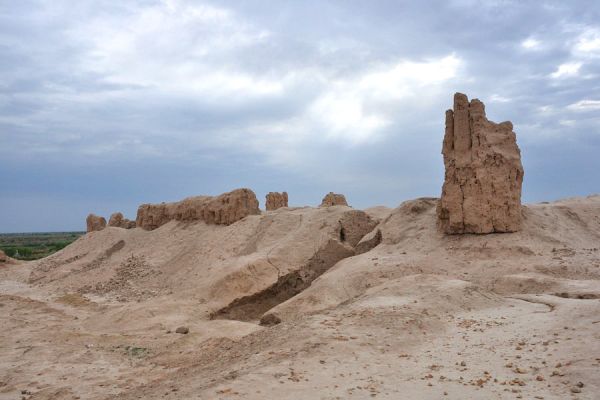Janbas-kala
One hundred and sixty kilometers from Urgench, in the territory of the Ellikkalinsky district of Karakalpakstan, there is one of the outstanding ancient monuments of Central Asia – the fortress of Dzhanbas-Kala, which scientists date back to the IV century BC. Dzhanbas-kala was built on a desolate hill, completing a chain of hills stretching southeast from Sultanuizdag.
Its double, five-meter-thick fortress walls, sometimes covered with sand dunes, reach a height of ten meters. There is a passage about three meters wide between the outer and inner walls of the fortress. The lower part of the walls up to the level of the loopholes is adobe, with a layer of bricks, above the walls are made of square mud bricks with sides measuring forty centimeters each.
The outer walls of the fortress are pierced along the entire perimeter by narrow and high arrow-shaped loopholes arranged in two rows in a checkerboard pattern. Passages were located between both rows of loopholes to accommodate the defenders of the fortress. Very narrow loopholes no more than twenty centimeters wide are designed for firing from the foot of the wall – "mounted combat". For this, steep slopes are arranged outside the loopholes. A characteristic feature of Dzhanbas-kala, which distinguishes it from many Central Asian fortresses, is the complete absence of towers, both angular and along the walls. However, the builders of the fortress provided all the options for repelling the enemy's attack. Structures consisting of one straight loophole and two oblique side loopholes facing in different directions were used to defeat the attackers from the flanks. Each group of such loopholes was located in a small arched niche, where only one shooter could fit. Such systems are located in the walls through twenty to thirty conventional loopholes.
The fortification art of the builders of Dzhanbas-Kala was fully manifested in an ingenious structure that protects the only gate leading to the settlement and has been perfectly preserved to this day. The rectangular projection of the wall at the gate has a narrow passage inside, similar to a maze and formed by five tower bastions built with bends at right angles. This passage is shot from loopholes from all sides. If the invaders managed to break through to the gate, then from the two arched passages leading from the passage inside the walls, the defenders of the settlement could meet the enemy with dignity with weapons in their hands.
A wide street about thirty meters leads from the fortress gate. On both sides of it there are two vast residential blocks, each of which consisted of about two hundred residential buildings. Consequently, the adult population of Jambas-kala was about two thousand people. A huge number of ceramic fragments, terracotta figurines and various metal objects have been found in the ruins of Janbas-Kala dwellings. Bracelets, rings, beads made of jet and crystalline pyrite, and, most importantly, many glass beads of various shapes and colors were found. Such beads were widely distributed in the northern Black Sea region in the III-II century BC, which proves the stable trade relations of ancient Khorezm with other countries.
The inhabitants of Janbaskala were adherents of Zoroastrianism, the oldest world religion that had dominated for more than a thousand years in a vast territory from Khorezm to India and from Xinjiang to the Near and Middle East. Opposite the gate, on the opposite side of the settlement, the ruins of the temple of fire adjoin the fortress wall. It was the center of the spiritual life of the inhabitants of Dzhanbas-kala. A regular oval elevation has been preserved in the sanctuary, where a sacred fire burned day and night on a metal altar, as prescribed by ritual. In the sanctuary, the remains of a stone bench have been preserved along the walls, sitting on which the priests supported an unquenchable fire with branches of fruit trees, here they performed a purification ceremony and sang hymns from the Avesta.
In the 1st century AD, the settlement was attacked by nomads. With the help of a battering ram, they made a wide gap in the wall south of the gate and broke into the fortress. The huge number of metal arrowheads of two types indicates a fierce battle inside the city. Apparently, most of the defenders died, and the survivors were captured and sold into slavery. The fire temple and residential buildings were destroyed and burned. For two thousand years, rains and winds have washed away the surviving buildings and covered them with sand, and only the walls of the fortress remind of the former greatness of Dzhanbas-kala.




















